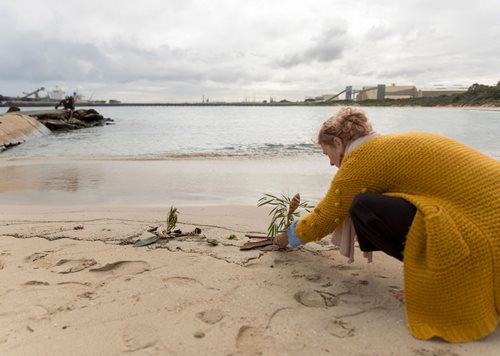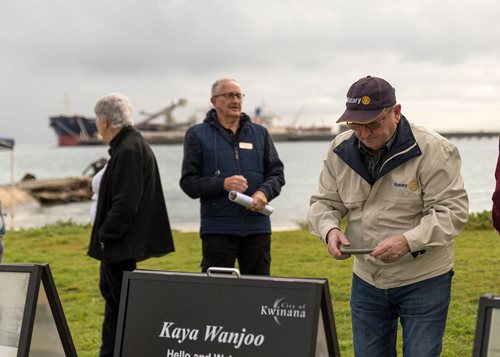The City of Kwinana held a commemorative event at Wells Park, Kwinana Beach, to mark 100 years since the SS Kwinana wrecked on our shores. The informal event allowed for connecting to community, place and history through a boat building workshop and a morning tea for a handful of our senior members of the community.
Thankfully the rain held out, creativity flowed, dolphins danced in the water close by and extraordinary story-telling occurred.
We were incredibly lucky to hear stories from Ronald Day, who in is 90’s now, lived on Kwinana Beach from 1938 and shared images and plans of the original blocks, cottages, shop and bakery of the settlement.
Tegan Jenkins facilitated a workshop on the beach where participants were mentored to build small boats using natural found materials, with a ‘message in a bottle’ for those who had passed, for their future selves and reflecting on the history of the site.
A new sign was also revealed which captures a snippet of the rich history of the SS Kwinana. An exhibition was also displayed at Darius Wells with some fantastic images of the huge ship that came to rest and later became our namesake.



Requiem for a ‘Pretty Maiden’
This Requiem was written by Hugh Edwards and was previously displayed on signage at Wells Park sponsored and erected by the Rotary Club of Kwinana.
When the keel of the steamer Darius was laid in a Sunderland shipyard in 1892 she was just another sturdy but undistinguished British merchantman in the making. And, as it turned out, she had a very ordinary and undistinguished career. It was a change of name (Kwinana), and a freak force of circumstance at the very end of her sea life that made her famous, and a landmark in WA history.
As the Kwinana blown ashore on a deserted beach a gutted hulk in 1922, she gave her name to the beach, to the seaside resort that sprang up there in later years, and finally the 40,000,000 pound oil refinery and the huge industrial centre that is now the pride of Western Australia. Kwinana is a name known among industrialists the world over and among oil men from the Persian Gulf to Texas. Meanwhile the wreck of the old ship lay rusting pleasantly on the foreshore with the gulls and the weekend picnickers for company - until this month when men with oxy-cutter torched and a purposeful air arrived. A landmark was doomed. The old wreck had been declared a danger to the children who played among the rusty girders, and it was held to be unsightly in this modern age. So the order went out that the remains of the Darius-Kwinana should be cut up for scrap metal and removed. As you read this Requiem the dismembering of the old ship will be continuing inexorably and soon the titled old fashioned stern, so familiar against the sunsets and Garden Island over the years, will be gone. Are there no tears for the old Kwinana? There are still men and women in WA who remember the day on July 16, 1912, when the Kwinana - gleaming in new paint and decked with bunting - was Queen for a Day in Fremantle Harbour.
After serving for 20 years in the horse-trade between India and Australia - the purpose for which she was built - the Darius had been bought by the West Australian government as their first ship for the North-west run. It was admitted even then that she was old and had seen her best days, but Premier Jack Seadden was determined to make the best of the occasion, and anyone who was anyone was invited to the re-christening of the ship. In addition to the 250 invited guests, uninvited citizens turned up to the tune of 1100, straining the afternoon tea facilities provided by Government House, the decks hardly used to the bustles and heels of high society after all the years of horse’s hooves. “I christen you Kwinana… may your enterprise bring wealth and prosperity to the people of Western Australia” said Mrs Seadden as she dashed a bottle of champagne over the appropriate part of the ship to the polite applause of the invited and uninvited guests. Jack Seadden himself then took to the floor and said that though Darius - now Kwinana - was an old ship there were still years of good service left in her and the state had bought a bargain. She had already showed a profit on her first trip from Newcastle (more applause) by bringing a load of coal for the WAGR and it was to be hoped that she would continue in this spirit.
Her new name was aboriginal for “Pretty Maiden” - though she was a square and unprepossessing as most British merchantman of her day. She steamed faithfully up and down the coast until 1920 when disaster struck the tired old ship at Canarvan jetty. A load of coal in her bunkers caught fire and unhindered by the efforts of the tiny town fire brigade, burnt the midships section, bridge and fo’castle to be blacked, twisted girders. Miraculously the engines still operated and it was decided to take her under her own steam with jury steering to Fremantle. After the crew demanded - and got - danger money for the proposed journey the voyage was accomplished in company with the small coaster Kalpurni. On her final voyage Kwinana averaged a commendable 6.5 knots. But further disaster overtook her. While manoeuvring in Fremantle harbour she collided with the S.S. Port Stephen and received more extensive damage. This was too much for her owners and they decided to strip everything worthwhile from her hull and put her out of commission rather than face the enormous cost of repairs after the fire and collision. So she was stripped, towed to Garden Island, and left to swing forlornly at anchor until on May 30, 1922 her cables parted and she drifted ashore on the mainland at the spot where she still lies… to become a famous name long after her sea service was over. If you’re going past in the next few weeks take a last look at the old Kwinana. She’s a symbol… a link between ages. Those girders were forged before the first car came to Australia, before the gold rushes of Coolgardie and Kalgoorlie brought ingot wealth to WA, when the bulk of the worlds trade was still carried by sailing ships.
For more local history see our History and Heritage page.